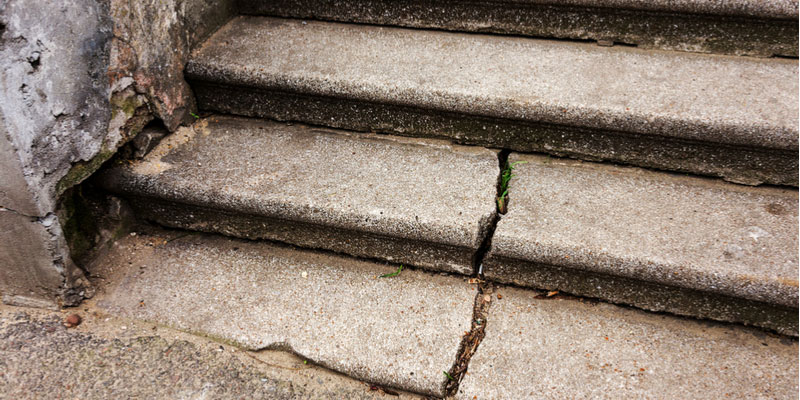Concrete step repair is a common necessity as foot traffic will wear down even the toughest set of stairs over time. Taking care of repairs as needed will keep steps looking good and lasting for a long time. Ignoring concrete step repairs only leads to quicker deterioration of surfaces. Sudden trauma can create large damages, but usually, damages start out small and then grow into something more.
Common concrete step repairs include:
- Stains
- Flaking
- Cracking
- Crazing – thin, spiderweb-like cracks that are shallow
- Discoloration
- Structural damage
Concrete step repair: Stains
Stained concrete is a common issue. After all, concrete is a light surface that comes into contact with a lot of different elements. Stains in hidden areas don’t need much attention, but a big stain in the center of the stairs that lead up to your house may cause you to sound the alarm for a solution.
Luckily, it’s relatively easy to remove most stains from concrete. Plus, there are plenty of solutions depending on the location and nature of the stain, as well as the quality of surfaces surrounding the blemish.
Something as simple as oven cleaner can be used to remove concrete stair stains caused by oil, grease, or transmission fluid. Simply spray onto the stained surface and let it sit for 5 to 10 minutes. Then, take a stiff brush and scrub at the stain before thoroughly rinsing the area with your garden hose.
Concrete step repair: Structural damage
Once the structure of the stairs begins to break down, the damages will get worse at a faster clip. This is especially true during cold weather so make sure to conduct repairs before winter sets in – ideally in early fall. Concrete may be too badly damaged to repair, thus requiring a rebuild. But, in many cases, the damaged portion can be fixed without touching the surrounding areas.
Fixing structural damage starts with cleaning up the destroyed portion and removing loose chunks. From there, it’s important to tape up the edges so that you don’t get new concrete on your existing (non-damaged) surfaces. From there, holes are filled in, a second coat is added, and the concrete is worked into the area with the proper coating applied on top. The process of patching and resurfacing concrete is best left to a professional.
Repair vs Replace Concrete Steps
If you’re looking at worn down or chipped concrete, chances are it’s an easy fix and you can repair instead of replacing. Although, sometimes it makes more sense to replace concrete steps. Signs that it’s time to replace instead of repair include:
- The concrete is badly deteriorated
- Damages relate to improper installation of the steps
- Surfaces cannot be restored to their original quality
A general way of looking at it is if the area in need of repair requires over 2 inches of material to fix, then it might make more sense to replace the concrete. For smaller damages, there are many different products available to easily address the situation. A professional will be able to fix more badly progressed damages than DIY options.
Don’t Forget About Concrete Step Maintenance
Maintenance is vital to preventing issues that lead to the need for repairs in the first place. Some ways to maintain the quality of your concrete steps include:
- Keep surfaces clean, hose and sweep the area regularly to prevent a buildup of debris
- Wash away oil and other fluids right away
- Patch small cracks as they appear
- Get concrete sealed every-so-often
- Keep concrete surfaces free of deicers in the winter, especially the first year after concrete sets.
Need help with your concrete steps? Call Turnbull Masonry! We specialize in concrete installation, repairs, and rebuilds.

